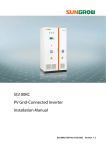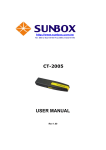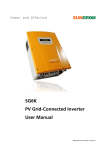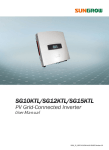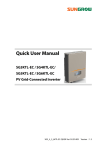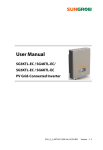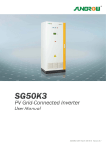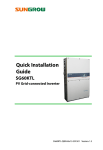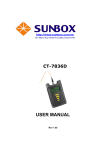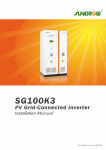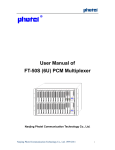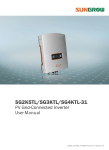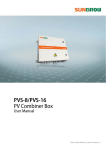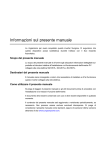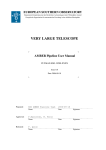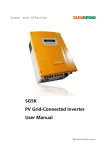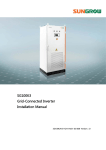Download Installation_Manual-EN- SG100KU
Transcript
SG100KU PV Grid-Connected Inverter Installation Manual SG100KU-IEN-Ver13-201202 Version: 1.3 About This Manual Thank you for purchasing the SG100KU from Sungrow Power Supply Co., Ltd.. We hope you will be satisfied with this device along with your entire PV plant system. Aim The aim of this manual is to give safety instructions, detailed setup information for the installation of SG100KU PV grid-connected Inverter. Target Readers The manual is provided to people who need to set up a system that includes the SG100KU grid connected inverter. Installers must be qualified electricians only. How to Use This Manual Read this manual and the other documents, before installation of the SG100KU. The document must be stored near the installation and must be available at all times. The contents of this manual will be periodically updated or revised if necessary. However discrepancies cannot be excluded. Please make the object as the standard or download the latest version of this manual via www.sungrowpower.com. I IMPORTANT SAFETY INSTRUCTIONS SAVE THESE INSTRUCTIONS Symbols Explanation Important instructions contained in this manual should be followed during installation of the inverter. And they will be indicated by these symbols. DANGER indicates a hazard with a high level of risk which, if not avoided, will result in death or serious injury. WARNING indicates a hazard with a medium level of risk which, if not avoided, could result in death or serious injury. CAUTION indicates a hazard with a low level of risk which, if not avoided, could result in minor or moderate injury. NOTICE indicates a situation which, if not avoided, could result in equipment malfunction or property damage. NOTE indicates additional information, emphasized contents or tips to help you solve problems or save time. II Contents About This Manual .................................................................................................................................... I Aim ..................................................................................................................................................... I Target Readers..................................................................................................................................... I How to Use This Manual............................................................................................................................. I IMPORTANT SAFETY INSTRUCTIONS.............................................................................................................. II SAVE THESE INSTRUCTIONS ......................................................................................................................... II Symbols Explanation .......................................................................................................................... II 1 Safety Instructions ................................................................................................... 1 1.1 Appropriate Usage .............................................................................................................................. 2 1.2 Safety Instructions .............................................................................................................................. 3 1.3 Emergency Stop Button ...................................................................................................................... 5 1.4 Grid (AC) Main Switch.......................................................................................................................... 5 1.5 DC Main Switch................................................................................................................................... 6 1.6 Open the Door of SG100KU ................................................................................................................. 6 2 Delivery ..................................................................................................................... 7 2.1 Scope of Delivery ................................................................................................................................ 8 2.2 Identify SG100KU ................................................................................................................................ 9 2.3 Storage of SG100KU .......................................................................................................................... 10 3 Introduction ............................................................................................................ 11 3.1 Basic Structure and Appearance......................................................................................................... 12 3.2 Dimensions and Weight .................................................................................................................... 14 3.3 The Bottom and Top Views................................................................................................................. 15 3.4 Electrical Connections Interface ......................................................................................................... 16 3.5 Data Acquisition................................................................................................................................ 17 3.5.1 Data Display ............................................................................................................................. 17 3.5.2 Fault Indication ........................................................................................................................ 17 3.5.3 Serial Data Access ..................................................................................................................... 17 3.6 General Requirements ....................................................................................................................... 17 3.6.1 Grid Requirements.................................................................................................................... 17 III 3.6.2 Ventilation Requirements .......................................................................................................... 17 3.6.3 Installation Requirements ......................................................................................................... 17 3.6.4 Personnel Requirements ........................................................................................................... 18 3.6.5 Communication Requirements.................................................................................................. 18 4 Installation Design ................................................................................................. 19 4.1 The Solution with Optional Devices from SUNGROW .......................................................................... 20 4.2 Basic Requirements ........................................................................................................................... 21 4.3 Installation Environment Design ........................................................................................................ 21 4.3.1 Floor ........................................................................................................................................ 21 4.3.2 Clarence Space ......................................................................................................................... 22 4.3.3 Cable Trench ............................................................................................................................ 22 4.3.4 Ventilation................................................................................................................................ 23 4.3.5 Other Protections ..................................................................................................................... 23 4.4 Wiring Specification .......................................................................................................................... 24 4.5 Tightening Torques and Cable Protection ........................................................................................... 25 4.5.1 Tightening Torques for Power Cable Connections....................................................................... 25 4.5.2 Cable Protections ..................................................................................................................... 25 4.6 Installation Process ........................................................................................................................... 25 5 Preparations for Installation ................................................................................ 27 5.1 Checking the Unit ............................................................................................................................. 28 5.2 Required tools .................................................................................................................................. 28 6 Mechanical Installation ......................................................................................... 29 6.1 Transport and Shipping ..................................................................................................................... 30 6.1.1 Attentions ................................................................................................................................ 30 6.1.2 Moving the Packed SG100KU .................................................................................................... 31 6.2 Field Installation ............................................................................................................................... 35 6.2.1 Unpacking the Unit .................................................................................................................. 35 6.2.2 Place the SG100KU ................................................................................................................... 36 6.2.3 Fastening the SG100KU to Floor ................................................................................................ 36 7 Electrical Connection............................................................................................. 37 7.1 Cable Specifications .......................................................................................................................... 38 7.2 Parts for Cabling ............................................................................................................................... 39 7.3 Start Electrical Connections ............................................................................................................... 40 7.3.1 Open the Door ......................................................................................................................... 40 7.4 Open the Cable Holes........................................................................................................................ 41 7.5 DC Connections ................................................................................................................................ 42 7.6 AC Grid Connections ......................................................................................................................... 44 7.7 Ground Connections ......................................................................................................................... 45 IV 7.8 Communication Connection (Optional).............................................................................................. 47 7.9 Close the Cable Holes ........................................................................................................................ 48 8 Installation Checklist ............................................................................................. 49 9 Commissioning ....................................................................................................... 51 9.1 Requirements of Commissioning ....................................................................................................... 52 9.2 Inspection before Start-up................................................................................................................. 52 9.2.1 PV Array Check ......................................................................................................................... 52 9.2.2 SG100KU Check ........................................................................................................................ 52 9.2.3 Ground Connection Check ........................................................................................................ 52 9.2.4 Serial Communication Check (Optional) .................................................................................... 53 9.2.5 Voltages Check ......................................................................................................................... 53 9.3 Start the Inverter ............................................................................................................................... 53 9.4 Complete the Commissioning ........................................................................................................... 54 10 Appendix ............................................................................................................... 55 10.1 Technical Data ................................................................................................................................. 56 10.1.1 DC Parameters ........................................................................................................................ 56 10.1.2 AC Parameters ........................................................................................................................ 56 10.1.3 System ................................................................................................................................... 57 10.1.4 Display and Communication ................................................................................................... 57 10.1.5 Mechanical Parameters ........................................................................................................... 57 10.2 Exclusion of Liability ........................................................................................................................ 58 10.3 About Us ......................................................................................................................................... 59 V Figures Fig 1-1 PV Generation System with SG100KU .......................................................................................................................................... 2 Fig 2-1 Nameplate ............................................................................................................................................................................................. 9 Fig 3-1 Simple Circuit Diagram of SG100KU ........................................................................................................................................... 12 Fig 3-2 External Appearance of SG100KU ................................................................................................................................................ 13 Fig 3-3 Dimensions and Weight of SG100KU.......................................................................................................................................... 14 Fig 3-4 Bottom View of SG100KU ............................................................................................................................................................... 15 Fig 3-5 Top View of SG100KU ....................................................................................................................................................................... 15 Fig 3-6 Electrical Connections Interfaces of SG100KU ........................................................................................................................ 16 Fig 4-1 The Solution from SUNGROW ....................................................................................................................................................... 20 Fig 4-2 Clearance Space around the SG100KU ...................................................................................................................................... 22 Fig 4-3 Sectional Drawing of Cable Trench ............................................................................................................................................. 23 Fig 4-4 Installation Process of the SG100KU ........................................................................................................................................... 26 Fig 6-1 Moving the Packed SG100KU ........................................................................................................................................................ 32 Fig 6-2 Using a Forklift to Move the SG100KU with the Wooden Pallet ........................................................................................ 33 Fig 6-3 Using a Forklift to Move the SG100KU ....................................................................................................................................... 33 Fig 6-4 Using Rail Steels or Crane to Move the SG100KU ................................................................................................................... 34 Fig 6-5 Cross-section View of the SG100KU Fasten on the Wooden Pallet ................................................................................... 35 Fig 6-6 Fastening the SG100KU ................................................................................................................................................................... 36 Fig 7-1 Power Cable Connection Terminal .............................................................................................................................................. 39 Fig 7-2 Open the Main Switches ................................................................................................................................................................. 40 Fig 7-3 Open the Latch ................................................................................................................................................................................... 40 Fig 7-4 Remove the Protective Shield ....................................................................................................................................................... 41 Fig 7-5 DC Input Cable Routing .................................................................................................................................................................. 43 VI Fig 7-6 AC Output Cable Routing ............................................................................................................................................................... 44 Fig 7-7 Ground Cable Routing ..................................................................................................................................................................... 46 Fig 7-8 Serial Communication Cable Routing ........................................................................................................................................ 47 Fig 7-9 Serial Communication Interface Connection........................................................................................................................... 47 VII Tables Table 1-1 System Devices Type...................................................................................................................................................................... 2 Table 2-1 Scope of Delivery ............................................................................................................................................................................ 8 Table 4-1 Min. Distances between Control Cable and Power Cable ............................................................................................... 24 Table 4-2 Tightening Torques for Power Cable Connections ............................................................................................................ 25 Table 4-3 Installation Process Descriptions ............................................................................................................................................. 26 Table 6-1 Symbol and Data Name on Crate ............................................................................................................................................ 31 Table 7-1 DC Cables Recommended Sizes .............................................................................................................................................. 38 Table 7-2 AC Cables Recommended Sizes ............................................................................................................................................... 38 Table 7-3 Ground Cables Recommended Sizes ..................................................................................................................................... 38 Table 7-4 Communication Cables Recommended Sizes .................................................................................................................... 39 VIII 1 Safety Instructions About This Chapter This chapter describes the appropriate usage and provides some important safety instructions about SG100KU. 1 SG100KU Installation Manual 1.1 Appropriate Usage Grid-Connected PV system consists of PV modules, grid-connected inverters, metering device and power distribution system (as shown in Fig 1-1). The solar energy is converted into DC current by PV modules and is fed into the local power grid network by the grid-connected inverter which synchronized the frequency, phase and pure sine waveform with the power network. Fig 1-1 PV Generation System with SG100KU No. Description A PV Arrays B SG100KU PV Grid-Connected Inverter C Utility Grid Table 1-1 System Devices Type Device Type PV Arrays Monocrystalline Silicon, Polycrystalline Silicon, Amorphous Silicon, Thin Film Cells Utility Grid TT, TN-C, TN-S, TN-C-S, IT Optional Devices Solar Info EM Environment Monitoring Device SunBox PVS PV Array Combiner Box SunBox PMD-D DC Power Distribution Cabinet SunBox PMD-A AC Power Distribution Cabinet Solar Info Logger Inverter Data Acquisition and Transmission Device 2 Safety Instructions 1 1.2 Safety Instructions Pay attention to the following safety instructions: Shock Hazard! Death results from burning and electric shock upon touching the SG100KU live components. z Do not touch the live components of the SG100KU. z Observe all safety regulations. Shock Hazard! The enclosure of SG100KU inverter may contain high voltage conductors. The enclosure doors should be kept locked during operation, except for maintenance or testing. To avoid the risk of electric shock, do not perform any action or operation which is not included in the operating instructions unless you are qualified to do so. Shock Hazard! The SG100KU inverter will immediately shutdown if users want to open the front door during operation. Please check the unit is thoroughly shut down and isolated from the public grid and PV arrays before opening the front door. To avoid the risk of electric shock, a minimum 5 minutes is needed for any stored potentials that still left in the inverter after shut-down to be discharged before opening the door. 3 SG100KU Installation Manual Lethal Voltage! Damage to the SG100KU may result death by electric shock or fire! z Only operate SG100KU when it is safe to do so! z Only operate SG100KU when no damage is visibly apparent! DC Voltage! The PV array will provide DC voltage to the inverter when exposed to light, which may cause an electrical shock during installation, wiring or maintenance if not covered. Limitation of Use! The SG100KU Photovoltaic Grid-Connect Inverter is not intended for use in connection with life support systems or other medical equipments or devices. z Do not install on or over combustible surfaces. z More than one live circuit, see diagram. ESD Protection! The SG100KU may be damaged irreversibly by electrostatic discharge (ESD) at its components. z During the operation of SG100KU, please observe all the ESD related safety regulations! z Discharge any ESD by touching the grounded SG100KU conductor before contacting any electronic components! 4 Safety Instructions 1 For use in a controlled environment, refer to manual for environmental conditions. Service Safety! Thoroughly inspect the equipment prior to energizing. Verify that no tools or equipment have inadvertently been left behind. Never work alone when servicing this equipment. Two persons are required until the equipment is properly de-energized, locked out and verified de-energized with a meter. Please keep this installation the manual and other related documents in the handy place of the SG100KU. These documents must be available to operators and maintenance personnel at all times. 1.3 Emergency Stop Button The Emergency stop button will shutdown the inverter (disconnects the AC contactor and stops the IGBT matrix) immediately when it is punched (pressed down). The inverter must be started up manually through LCD control menu if users want to recover the operation after the button is punched. 1.4 Grid (AC) Main Switch The grid main switch is one of the primary disconnects for the inverter. The inverter's doors cannot be opened until the switch of the grid main switch is in the OFF position. When the AC main switch is in the OFF position, all AC power is disconnected (not live), except the following areas: z The input side of the AC circuit breaker (the utility grid) z The DC input terminals (if the PV array is connected and energized) 5 SG100KU Installation Manual To operate the inverter the AC circuit breaker switch must be in the ON position. 1.5 DC Main Switch The DC main switch is also the primary disconnect for the inverter. The inverter's doors cannot be opened until the switch of the DC circuit is in the OFF position. When the DC main switch is in the OFF position, all DC power is disconnected (not live), except the following areas: z The input side of the AC main switch (the utility grid) z The DC input terminals (if the PV array is connected and energized) To operate the inverter the DC circuit breaker switch must be in the ON position. 1.6 Open the Door of SG100KU Use the following procedure to shut down the SG100KU inverter before servicing: 1. Stop the inverter from the LCD control menu. 2. Switch off the AC main switch (turn the switch to OFF position) 3. Switch off the DC main switch (turn the switch to OFF position). 4. Press in the handle to make it pop out from the lock hole, turn it right. 5. Now you can open the front door. 6 2 Delivery About This Chapter This chapter provides the scope of delivery of SG100KU, nameplate and storage method. 7 SG100KU Installation Manual 2.1 Scope of Delivery The following materials in Table 2-1 should be included in the crate. Table 2-1 Scope of Delivery No. Name Note 1 SG100KU PV Grid-Connected Inverter Including key and parts for cabling 2 SG100KU Installation Manual - 3 SG100KU Operation Manual - 4 Warranty Card - 5 Certificate of Quality - 6 Product Test Report - User can download the latest version of this manual and the monitoring software via www.sungrowpower.com. 8 Delivery 2 2.2 Identify SG100KU You can identify the SG100KU using the nameplate. There are two nameplates located on the back panel and inside the door as shown in Fig 2-1. Fig 2-1 Nameplate *The picture is for reference only; the actual item is standard. No. Description A SUNGROW Logo and product type B Parameters C Marks of certification institutions of SG100KU D Company name, website and origin 9 SG100KU Installation Manual 2.3 Storage of SG100KU If there is a long time before installation or operation, SG100KU should be deposited appropriately. z Pack SG100KU up in the crate. z Keep the desiccant bags in the crate. z SG100KU can only be stored when it is stopped and all the doors are closed in a dry room to protect the internal circuits against dust and moisture. z Routine check at least once a week. z Unpacking check and change desiccant bags every 6 months. Keep the crate upright. No stacking on top of the crate. After long term storage, a thorough test of SG100KU is necessary. 10 3 Introduction About This Chapter This chapter provides basic information about SG100KU. 11 SG100KU Installation Manual 3.1 Basic Structure and Appearance SG100KU is an advanced and reliable three-phase grid connected inverter for solar power generation system with a rating of 100kW. The SG100KU inverter utilizes the advanced power conversion technology with the latest IGBT, to convert the DC power from the photovoltaic array to stable three-phase AC power and then feed the power to the utility grid through filter and isolation transformer, see Fig 3-1. Fig 3-1 Simple Circuit Diagram of SG100KU 12 Introduction 3 Fig 3-2 shows the locations of basic controlling and information display elements that help users perform control and monitoring tasks. Fig 3-2 External Appearance of SG100KU No. Component Name Comments A LED Indicators Power, Operation and Fault B LCD and Keys Display data and perform control functions C Emergency Stop Button Shut down the inverter when pressed down D DC Main Switch DC side circuit breaker switch E GRID Main Switch AC side circuit breaker switch 13 SG100KU Installation Manual 3.2 Dimensions and Weight The SG100KU inverter’s dimensions are 40inchx77inchx30inch(1020mmx1964mmx770mm, W×H×D, including the devices on the front panel). The SG100KU inverter weighs approximately 1984 Ibs (900 kg). Please take this large dimensions and heavy weight into consideration during shipping, moving and installation. Fig 3-3 Dimensions and Weight of SG100KU 14 Introduction 3 3.3 The Bottom and Top Views Cables and a part of cooling air come into the cabinet through the bottom panel, see Fig 3-4. 1.2 in. 4x0.55in.x0.79in. 11.8 in. 11.8 in. 5.9 in. 5.9 in. 25.6 in. 31.5 in. Unit:inch Fig 3-4 Bottom View of SG100KU Cooling air is fed in via the base inlet and shutters on front and rear panels. The cooling air outlets are on the top of the SG100KU. Cooling fans’ power consumption is 240W and the outlet air flow is 60000ft3/h (1620m3/h), see Fig 3-5. 36.8 in. 10.4 in. 60000ft3/h 7.1 in. 11.3 in. 10.8 in. 25.6 in. 10.4 in. 5.7 in. Unit:inch Fig 3-5 Top View of SG100KU 15 SG100KU Installation Manual 3.4 Electrical Connections Interface SG100KU provides multiple electrical terminals, see Fig 3-6. A B C D E Fig 3-6 Electrical Connections Interfaces of SG100KU No. Name Comments A RS485 Terminals - B DC- Input Terminals - C AC Output Terminals To 3-phase Grid through AC main breaker. Leave N Vacant in 3-phase-3-wire grid system D DC+ Input Terminals - E Ground Terminal Must be connected to protect operators from leakage current. 16 Introduction 3 3.5 Data Acquisition 3.5.1 Data Display The inverter will display real-time and logged running data of the inverter to the equipped LCD interface. 3.5.2 Fault Indication The inverter can record the time and type of all faults in non-volatile memory and inform the fault state to the customers through LCD and LED. 3.5.3 Serial Data Access All the data and fault information can be accessed by a remote computer via serial port communication when necessary. The inverter has a basic RS485 communication method and can be extended to a variety of communication approaches, which including Ethernet, Internet, and GPRS by utilization of proper external adapters or modems. 3.6 General Requirements 3.6.1 Grid Requirements The output of SG100KU is designed to fit the 480V 3-phase-4-wire grid system, which includes L1, L2, L3, Neutral and power ground. 480V 3-phase-3-wire grid is acceptable. In 3-phase-3-wire grid, neutral terminal of SG100KU can be left vacant. 3.6.2 Ventilation Requirements Maintain a minimum of 24inch (600mm) clearance in back, 48inch (1200mm) in front and 24inch (600mm) on top of the SG100KU for proper ventilation and installation operation. 3.6.3 Installation Requirements All installation practices on the SG100KU may only be performed when the device is safely de-energized with all the DC and AC power sources and all the power switches are secured against being switched on. SG100KU are designed with some fans for cooling and ventilation. 17 SG100KU Installation Manual Work on the fans may only be performed after all insulation measures have been taken. 3.6.4 Personnel Requirements Only qualified technical personnel, who are familiar with the installation of the system, may undertake any such work. 3.6.5 Communication Requirements The basic communication interface of SG100KU is a RS485 serial communication, which can be easily connected to a PC through a RS485/RS232 Converter. An Ethernet method and GPRS method can be extended optionally with specific device, which can also be ordered from Sungrow. 18 4 Installation Design About This Chapter This chapter provides the PV plant system solution with optional devices from SUNGROW, information about how to design the installation environment, how to arrange installation procedure. Read this chapter to get information for installing the SG100KU. 19 SG100KU Installation Manual 4.1 The Solution with Optional Devices from SUNGROW PV Grid-connected system configured with optional devices from SUNGROW is shown in Fig 4-1. Fig 4-1 The Solution from SUNGROW No. Name Comments A Solar Info EM Environment Monitoring Device Applied to PV power generation system to measure the wind speed, wind direction and solar radiation. B SunBox PVS PV Array Combiner Box By using PV array combiner box, different strings of PV array can be converged into the PV array string box. After that, together with lightning arresters and circuit breakers, it is connected to the inverter to reduce the system installation time and increase the system safety. C SunBox PMD-D DC Power Distribution Cabinet The DC distribution unit collects the DC current from PV arrays and feeds into the inverter, which mainly contains DC input circuit breakers, diodes and PV lightning protection device. D SunBox PMD-A AC Power Distribution Cabinet The AC distribution unit is a distribution and protection interface between inverter and the utility network, which contains grid-side circuit breaker, lightning protection devices and power meters. E Solar Info Logger Inverter Data Acquisition and Transmission Device Data acquisition device is used for processing the data from PV power plants which can be communicated with the PV grid-connected inverter for PV power plants. It is capable of monitoring one singular inverter and even up to 100 inverters. 20 Installation Design 4 4.2 Basic Requirements Following requirements listed below are met to ensure the normally operating of SG100KU. z Avoid moisture and wet place. z Install indoor and avoid sunlight and rain. z Don’t install SG100KU in unstable place. z Install in the place where you can see the LED indicators or LCD display clearly. z Ambient temperature range: -13°F~131°F (-25°C~55°C). z Maintain spaces around the SG100KU for proper ventilation, installation operation or passage (escape route). z Good ventilation and clean cooling air supply 4.3 Installation Environment Design There are air outlets on the top of the SG100KC. Therefore, at on-site field, air ducts must be installed to avoid foreign bodies’ entry. The SG100KU should be installed in electrical service room. The floor, wall clearances, ventilation equipments and precaution devices should be designed by professional personnel and satisfy the following requirements. 4.3.1 Floor The foundation must guarantee solid and safe positioning of the inverter. It must provide the load-carrying capacity necessary to cope with the weight of the inverter. SG100KU is designed for indoor use only and must be placed to a level concrete floor or pad. Any existing unevenness, depressions or slope must be corrected prior to installation. Prior to placing the inverter, users should bear in mind that the cables should enter the inverter from underneath and through the cable entry holes. 21 SG100KU Installation Manual 4.3.2 Clarence Space Maintain a minimum of 24inch (600 mm) clearance in back, 48inch (1200mm) in front and 24inch (600mm) on top of the SG100KU for proper ventilation and installation operation. The space from the top of the enclosure to the installation site ceiling must be left enough for ventilation and maintenance; otherwise maintenance personnel cannot open the top panel. Fig 4-2 Clearance Space around the SG100KU 4.3.3 Cable Trench The external cables of the SG100KU route into or out of the cabinet via the base. Cable trenches or steel supports above the floor are recommended (Refer to relevant design guides or standards). Well electrical connection is needed between different cable trenches and GND terminals. 22 Installation Design 4 Cable support arms can be used to support cables. Signal cables should be separated from power cables for a distance to avoid interference. A B Fig 4-3 Sectional Drawing of Cable Trench No. Name A Cable Trench B Cable Support Arms 4.3.4 Ventilation The heat generated (exhaust hot air) by the SG100KU must be dissipated out of the electrical service room as soon and as much as possible, in order to guarantee safe operation and high feed-in power. z High circulation of air is required. z Plenty of fresh air is available. z Air is pure and without dusts (classification 3S2). z Ventilation equipments are necessary, e.g. fans, blowers, ventilation grilles. z Exhaust fans are recommended to keep air pressure balance. z Directions of air inlet and outlet should be designed according to the local wind direction. z Measures for dust and rain-proof of air inlet and outlet are necessary. z The sizes of air pipes should be designed according to the air quantity by professional personnel. 4.3.5 Other Protections The SG100KU has the Ingress Protection 20(TYPE 1), and should be installed in dry, clean industrial environment in the term of EMC threshold and noise level. 23 SG100KU Installation Manual During operating the SG100KU will make some noise (≤80db), install the SG100KU in industrial environment and avoid the vicinity to living area or office area. After wiring, the cable entry and exit holes should be covered by the slid plates. And the rest gaps should be filled by urethane foam in order to keep mouse or other creatures from entering the cabinet. Installation location must be dry, including no unexpected condensation. 4.4 Wiring Specification Cables in SG100KU can be classified into power cable and control (data) cable. It is recommended that the power cable and control cables be installed on separate cable support arms. Avoid long parallel runs of the two kinds of cables in order to decrease electromagnetic interference. Where control cables must cross power cables make sure they are arranged at an angle as near to 90° as possible. Do not run extra cables through the inverter. The cable support arms must have good electrical bonding with each other and to the grounding electrodes. Aluminum cable support arm systems can be used to improve local equalizing of potential. Table 4-1 shows the recommended minimum distances between different parallel lengths shielded control cable and power cable. Table 4-1 Min. Distance between Control Cable and Power Cable Parallel length (inch,m) Min. Distances (inch,m) 7874 inch (200m) 12 inch (0.3m) 11811 inch (300m) 20 inch (0.5m) 19685 inch (500m) 48 inch (1.2m) 24 Installation Design 4 4.5 Tightening Torques and Cable Protection 4.5.1 Tightening Torques for Power Cable Connections Tighten the cable with the proper torque shown in Table 4-2; for fear of loosen of cable lugs that may cause poor contact or high contact resistance, even fire. Table 4-2 Tightening Torques for Power Cable Connections Screw size Torque(in-Ibs, N·m) M4 18 in-Ibs (2 N·m) M5 28 in-Ibs (3.2 N·m) M6 62 in-Ibs (7 N·m) M8 142 in-Ibs (16 N·m) M10 301 in-Ibs (34 N·m) 4.5.2 Cable Protections z Protection of communication cable: − Communication cables are thin and easily to be broken. Lay power cables first then communication cables. − Communication cables should be laid in cable trench or cable support arms or tighten up by cable ties. − z Avoid heat element and the strong electric filed. Protection of power cables: − Strong electric current in power cables. Protect the insulating layer from sharp edges. − Tighten power cables up with insulated cable ties if necessary. 4.6 Installation Process Fig 4-4 shows the installation process of the SG100KU. And Table 4-3 gives a description about it. 25 SG100KU Installation Manual Table 4-3 Installation Process Descriptions Process Specification Reference Preparations before Installation Checking the unit 5 Preparations for Installation Mechanical Installation Transport and shipping Electrical Connection Open the door Required tools 6 Mechanical Installation Field installation 7 Electrical Connection DC connections AC grid connections Ground connection Communication connection Installation Check Check mechanical installation 8 Installation Checklist Check electrical connection Others Commissioning Check before commissioning Preparations before start-up Start-up procedure Complete the commissioning Fig 4-4 Installation Process of the SG100KU 26 9 Commissioning 5 Preparations for Installation About This Chapter This chapter illustrates preparations for installation of the SG100KU, including checking the unit and required tools. 27 SG100KU Installation Manual 5.1 Checking the Unit The first thing users must do after receiving the unit is to check the packaging and the device for any possible damage, verify the contents of the delivery with the delivery list. Please contact Sungrow immediately in case you find any visual damage or lost of the delivery components supposed to be included in the package. Check that there are no signs of damages. Before installation and operation, check the information on the crate to verify that the delivery is of the correct type. Only intact unit may be installed! 5.2 Required tools The tools required for moving the unit to its final position, fastening it to the floor, tightening the connections are listed below: z Crane, fork-lift or pallet truck (check load capacity), rail steels, jack and rollers z Torque wrench z Screwdrivers for the tightening of the frame screws z Set of wrenches and sockets z Wire stripper z Pliers z Inner hexagon spanner z Alcohol blast burner or hot air blower z Meg-ohmmeter or multimeter 28 6 Mechanical Installation About This Chapter This chapter describes the mechanical installation procedure of the SG100KU. 29 SG100KU Installation Manual 6.1 Transport and Shipping 6.1.1 Attentions The SG100KU inverter should be transported or installed as an integrated unit. Never disassemble it without the permission of SUNGROW. Always keep the SG100KU upright! Avoid sudden force! Only the specific transport methods for SG100KU are acceptable. And note the heavy weight of the equipment and the non-central center of gravity. The SG100KU inverter weighs at least 1984 Ibs (900kg). Please take this heavy weight into consideration during shipping and moving. Lay the power cables before the mechanical installation of the SG100KU. 30 Mechanical Installation 6 6.1.2 Moving the Packed SG100KU Pay attention to the symbols and data on the crate, to make an informed choice on modes of transport and installation site, see Table 6-1. Table 6-1 Symbol and Data Name on Crate Symbol or Data Name Specification THIS END UP KEEP UPRIGHT FRAGILE KEEP DRY CAUTION AGAINST WET MODEL NO.: Type of the inverter SIZE: Package Dimensions N. W.: Net Weight G. W.: Gross Weight 31 SG100KU Installation Manual Forklift or crane can be employed to move the crate that contains the SG100KU. z z The recommended way to transport the SG100KU is using forklift, see Fig 6-1 A: − Place the forks of the forklift to the bottom of wooden crate. − Elevate the SG100KU from beneath the wooden crate. The crane can be used to move the wooden crate, see Fig 6-1 B: Flexible slings with lock catches on both ends are recommended. You can order the slings from SUNGROW. Fig 6-1 Moving the Packed SG100KU 32 Mechanical Installation Move the SG100KU after Unpacking Forklift, rail steels or crane can be employed to move the SG100KU after unpacking. z If the unpacked SG100KU is far from the final position, the wooden pallet could be moved with the SG100KU, see Fig 6-2. Fig 6-2 Using a Forklift to Move the SG100KU with the Wooden Pallet z Using a forklift to move the SG100KU as following procedures, see Fig 6-3: 1. Remove the front and rear base covers. 2. Place the forks of the forklift below the SG100KU at the points specified. 3. Lift the SG100KU from beneath the enclosure. Be sure to use a forklift with a sufficiently spaced fork span. Fig 6-3 Using a Forklift to Move the SG100KU 33 6 SG100KU Installation Manual z Using rail steels to move the SG100KU to the final position, see Fig 6-4 A. Lubricant can be sprayed on the surface of the rail steels to make the movement easier. z If the only available way to move the SG100KU is by crane, you can order the angle irons and relevant parts for lifting from SUNGROW for free; see Fig 6-4 B. Fig 6-4 Using Rail Steels or Crane to Move the SG100KU 34 Mechanical Installation 6.2 Field Installation 6.2.1 Unpacking the Unit To unpack the SG100KU from the shipping crate: 1. Remove the crate’s wood side and top panels. 2. Remove the barrier bag material from the inverter. 3. Remove the inverter’s anchor hardware that bolts the inverter to the pallet. − Remove the front and rear base covers. − Unscrew the nuts under the wooden pallet. − Pull up the bolts. Fig 6-5 Cross-section View of the SG100KU Fasten on the Wooden Pallet 35 6 SG100KU Installation Manual 6.2.2 Place the SG100KU To place the enclosure on the mounting surface: 1. Make sure the mounting surface is level. 2. Move the SG100KU into position. 6.2.3 Fastening the SG100KU to Floor SG100KU must be fastened to the floor as follows: 1. Remove the front and rear base covers. 2. Fasten the cabinet to the channel steels or floor using M12 bolts and nuts, see Fig 6-6. Fig 6-6 Fastening the SG100KU 36 7 Electrical Connection About This Chapter This chapter describes the step-by-step electrical connection process needed to complete the installation the SG100KU. 37 SG100KU Installation Manual 7.1 Cable Specifications All wiring methods and processes should be in accordance with Local Electrical Code. The DC input cables (including DC positive and DC negative) must be chosen according to the recommended rating below. Table 7-1 DC Cables Recommended Sizes Cables and Bolt Requirements (mm2) Requirements (AWG) DC + cable At least 2 input cables with each 70 mm2 1/0 DC- cable At least 2 input cables with each 70 mm2 1/0 M8 Bolt (DC + and DC-) Torque: 16N.m The AC output cables (including L1, L2, and L3) must be chosen according to the recommended sizes below. Table 7-2 AC Cables Recommended Sizes Cables and Bolt Requirements (mm2) Requirements (AWG) Grid phase L1 cable 70 to 85 2/0 to 3/0 Grid phase L2 cable 70 to 85 2/0 to 3/0 Grid phase L3 cable 70 to 85 2/0 to 3/0 Grid phase N cable 70 to 85 2/0 to 3/0 M8 Bolt (L1, L2, L3) Torque: AWG 5 (16N.m) The ground cables must be chosen according to the recommended sizes below. Table 7-3 Ground Cables Recommended Sizes Cables and Bolt Requirements (mm2) Requirements (AWG) Ground cable 16 5 Earthing resistance should be less than 10W. 38 Electrical Connection 7 The communication cables must be chosen according to the recommended sizes below. Table 7-4 Communication Cables Recommended Sizes Cable Requirements (mm2) Requirements (AWG) Communication cable 0.75 18 Shield cables are recommended. Based on the above tables, users should use proper cables for different terminals with different specifications. 7.2 Parts for Cabling The parts for connecting power cables are provided on the copper bases. The sequence of the parts is shown in Fig 7-1. Incorrect connection of power cables will cause fires. Follow the sequence when connecting the power cables. No. Name A Copper Bus B Power Cable Lug C Bolt D Locking Washer E Washer F Nut Fig 7-1 Power Cable Connection Terminal 39 SG100KU Installation Manual 7.3 Start Electrical Connections 7.3.1 Open the Door The SG100KU is stopped and latched during shipping; users must open the front door of SG100KU for wiring. 1. Switch off both the AC and DC main switches (turn both the switches counter-clockwise). Fig 7-2 Open the Main Switches 2. Press down the doorlock to release the latch handle and turn the handle clockwise. Fig 7-3 Open the Latch 3. First open the left half door and then the right half door, identify the 2 transparent plastic shields (one in the upper position and one in the lower position). 4. It is necessary to take down the lower protective shield for wiring. Note that there are 4 screws (in the blue circle) to fix the shield, loose and take down them all. See Fig 7-4. 40 Electrical Connection 7 Fig 7-4 Remove the Protective Shield 7.4 Open the Cable Holes The external cables are routed into or out of the cabinet via the cable entry/exit holes at the bottom the SG100KU. The corresponding sliding plates should be removed for wiring. 1. Turn the screws in the back of the sliding plate counter-clockwise 2. Slide the plates backwards, to open the holes. The protective sponge tapes on the sliding plats protect the cables from scratch. Do not take them down! 41 SG100KU Installation Manual 7.5 DC Connections The DC input copper bus is located in the lower left corner of the inverter; there are 6 DC inputs in the DC copper bus with DT70 lugs. Cables rated for a minimum of 600V are required for connecting the inputs of the inverter. Because the maximum DC current may reach 340A and the connection terminals are M8 lugs, at least two AWG 1/0 (70mm2) DC input cables for each DC polarity are required. The DC cables to be connected must be rated for a minimum of 600V. Be careful not to connect the wrong DC input polarity. The voltage of the PV array must never exceed the maximum permissible inverter input voltage of 600V. 1. Ensure that the DC cables with no electricity. 2. Route the DC cables through the cable entry holes to the DC terminals, see Fig 7-5. 3. Connect the cables to DC (+) and DC (-) terminal on the DC circuit breaker respectively, refer to Fig 7-1. 4. Attach the DC cables to the terminals using appropriate screws. 42 Electrical Connection Fig 7-5 DC Input Cable Routing DC- grounding is required in contract. It connect DC- terminal to ground copper bus by leakage current sensor before leave factory. Therefore it is needed to firmly attach PE copper bar to grounding electrode. 43 7 SG100KU Installation Manual 7.6 AC Grid Connections To reduce the risk of fire, connect only to a circuit provided with 340A maximum branch circuits over current protection. When connect external AC cables to the SG100KU, positive phasing sequence must be maintained throughout the installation process. The connection terminals are located in the lower right corner of cabinet. Connection process as follows: 1. Ensure that the AC grid cables with no electricity. 2. Route the Line Grid L1, L2, L3 and Neutral cables through the cable entry holes to the AC terminals, see Fig 7-6. 3. Connect the cables to terminals marked L1, L2, L3 and N respectively, refer to Fig 7-1. 4. Secure the AC Line cables to the terminal with screws. Fig 7-6 AC Output Cable Routing 44 Electrical Connection 7 Note that the AC grid connection is designed to fit the 3–phase grid, which must be provided by the end-user, using a 3-phase system equipped for 480 V. In 3-phase-3-wire system, the “N” terminal could be vacant. 7.7 Ground Connections It is crucial for safety to connect all inverters to ground via appropriately sized conductor. PE copper bar has been firmly connected to enclosure of inverter inside the SG100KU before delivery. Therefore it is needed to firmly attach PE copper bar to grounding electrode. The cross area of grounding cable is AWG 5 (16mm2). The grid impedance must not exceed 10Ω. If there are one more inverters in parallel connection, a single-core yellow-green cable at least AWG 5 (16mm2) is needed to connect enclosure of all inverter to make equipotential for them. This will prevent current occurring in the shielding layer of communication cable because of different potential. Connect the factory ground to the ground terminal with leaking current detector, to realize the leaking current detect function. See Fig 7-7 . 45 SG100KU Installation Manual Fig 7-7 Ground Cable Routing This product can cause a DC current in the external protective earthing conductor. Where a residual current-operated protective (RCD) or monitoring (RCM) device is used for protection in case of direct or indirect contact, 46 Electrical Connection 7 7.8 Communication Connection (Optional) SG100KU supplies RS485 interface to install communication between inverter and a PC or a data logger. And there is also a RS485/RS232 converter needed to connect SG100KU to PC 1. Route the communication cables through the cable entry holes to the RS485 A/B terminals, see Fig 7-8. 2. Route the RS485A cable to the RS485/232 converter TX+ or RX+. 3. Route the RS485B cable to the RS485/232 converter TX- or RX-. 4. Secure the cables are tightened. 5. Connect the RS485/232 converter DB9 to the PC DB9 serial port, see Fig 7-9. Fig 7-8 Serial Communication Cable Routing Fig 7-9 Serial Communication Interface Connection 47 SG100KU Installation Manual If there are two or more inverters to be monitored, install communication system in series. z RS485 cable should be shielded twisted-pair for good communication(RVVP-2*1.0 shielded twisted-pair cable is recommended). z Shielding layer of RS485 cable should be single-point grounded in the site of monitor terminal. 7.9 Close the Cable Holes After all the electrical connections, cable holes must be closed to protect interior against dirt, soiling and creatures (mouse or pest). 1. Slide the plates forward until the flexible sponges’ seals are pressed the cables. 2. Turn the screws in the back of the sliding plate clockwise to fix the sliding plates. 3. Seal the rest gaps with urethane foam. 48 8 Installation Checklist About This Chapter This chapter describes the items needed to verify whether your installation of the SG100KU is correct. 49 SG100KU Installation Manual Check the mechanical and electrical installation of the inverter before commissioning. Go through the checklist below with another person together. Mechanical Installation □ Check all the mechanical connections and make sure there is no damage, scratch or abnormal parts □ The inverter has been fixed properly to floor. □ The clearance spaces around the inverter are proper. □ The ambient operating conditions are within the allowed range. □ Cooling air circulates smoothly. □ Protective enclosure seal is of integrity and reliability Electrical Installation □ The inverter is grounded properly. □ The polarity of PV input connections are correct. □ The grid voltage matches the nominal output voltage of the inverter. □ The grid connection to the output terminals is OK. □ The communication cable connections are correct. □ The communication cables are routed away from power cables. □ Marks on the cables are correct, clear and distinguishable □ Insulation shields are integrated and firm. □ Warning labels are clear and distinguishable. □ Make sure all the bolts that fix the cables are tightened and secured. Other □ There are no tools, foreign objects or dust from drilling inside the inverter. □ No condensing or icing in the cabinet. 50 9 Commissioning About This Chapter This chapter describes how to start the SG100KU for the first time, including requirements of commissioning, Inspection before start-up, start-up procedures and completing the commissioning. 51 SG100KU Installation Manual 9.1 Requirements of Commissioning Before starting the device for the first time, all work performed on the device should be checked thoroughly. Check the voltages of AC and DC sides meet the requirements of SG100KU. 9.2 Inspection before Start-up 9.2.1 PV Array Check Before start-up, check the PV array: 1. Check open-circuit voltage of each PV string matches the nominal input voltage. 2. Record the U-I curve if possible. 3. Record the environmental parameters(temperature, radiation intensity) 4. Measure and record the resistance of cables if possible. 9.2.2 SG100KU Check Before start-up check the SG100KU: 1. Ensure that the mechanical and electrical installation of the inverter has been checked according to 8 Installation Checklist. 2. Ensure that the DC and AC (GRID) Main switches are in OFF position. 3. Ensure that the Emergency Stop Button is released and functional. 9.2.3 Ground Connection Check Make sure the ground cable goes through the hole of the ground fault detection device and is connected to factory ground securely. 52 Commissioning 9 9.2.4 Serial Communication Check (Optional) For external communication monitoring, the data cables must be connected. Make sure that the RS485 A and B cables are connected correctly and tightened to the RS485/232 converter. Make sure the RS485/232 converter DB9 terminal is correctly connected to the PC DB9 serial port. 9.2.5 Voltages Check AC Grid Voltage Check It must be verified that the inverter is connected to the correct grid type and that a right-hand rotary field exists on L1, L2, L3 and Neutral. The value of the AC line to line voltage should be about 480 V. DC Voltage Check The DC connections are from the DC combiner boxes to the inverter. The voltage on the individual DC cables should be almost the same value and must never exceed the allowable maximum DC voltage. Besides the voltage values, the polarity of the DC inputs must also be verified. All DC connections should be checked to ensure that they are mechanically tight. The DC cables to be connected must be rates for minimum of 600V. 9.3 Start the Inverter If all tests and measurements have been performed, and all measured values lie within the acceptable range, then the device can be switched on for the first time. Before start up the SG100KU, ensure that: z Nobody is working on the inverter. z Cabinet doors are closed. To start the SG100KU: 53 SG100KU Installation Manual 1. Verify 480 VAC voltage of the grid line to line voltage. 2. Close the door of the enclosure. 3. Turn the AC (GRID) main switch to the ON position. 4. Turn the DC main switch to the ON position. 5. It will take about 1 minute for the auto-initialization of the power conversion circuit and the LCD panel. The “POWER” LED indicators both in the enclosure and in the LCD panel will burn; the “com” LED indicator will flash every 2 or 3 seconds. 6. If the DC voltage is below the DC voltage start point (Vpv<320V), then the “state” of the LCD interface will always show “Start-up”; 7. If the DC voltage exceeds the DC voltage start point (Vpv >320V) for 5 minutes, the SG100KU will automatically change to “Run” state, the “OPERATION” LED on the front door and the “RUN” LCD will both light, with the state of the LCD menu be changing to “Run”. 8. After the SG100KU entering normal operation, set the time to local time via LCD control panel, refer to the User Manual. Desynchronized time between the inverter and upper PC in the communication system may result in communication failure. 9.4 Complete the Commissioning If all the start procedures have been performed, check the operating condition of the SG100KU. 1. Check whether the following items are normal: noise, heat generation, no smoke or unusual odor. 2. Measure the grid-connected voltage, current and THD. 3. Check the ground of cabinet. 4. Check the LCD display and external communication. So far, the commissioning of the SG100KU is completed. SG100KU don’t need manual control in daily operation. z Keep the door closed and locked. z Key to the door must be stored by appointed personnel. 54 10 Appendix About This Chapter This chapter gives technical data of the SG100KU, exclusion of liability and the way to contact us. 55 SG100KU Installation Manual 10.1 Technical Data The following tables list the technical data of the SG100KU. Basic production information and performance of the SG100KU are available from these tables. 10.1.1 DC Parameters Parameter Specification Max. DC Voltage 600Vdc Start Voltage 320Vdc MPP Voltage Range 300~600Vdc Min. DC Voltage 300Vdc Max. DC Power 105kWp Max. Input Current 340A Recommend PV Array Open Circuit Voltage 450V 10.1.2 AC Parameters Parameter Specification Rated Output Power 100kW Max. AC Output Current 140A Rated Grid Voltage 480Vac Grid Voltage Range 422V~528Vac Rated Grid Frequency 60Hz Grid Frequency Range 59.3Hz~60.5Hz Output Current THD <3% at nominal power Power Injection <0.5% of rated inverter output current Power Factor (cosφ) 1 56 Appendix 10.1.3 System Parameter Specification Max. Efficiency 97.2% CEC Weight Efficiency 96.5%(with transformer) Protection Degree IP20 (Indoor) Power Consumption at Night <30W Operating Temperature -25°C ~ 55°C Cooling Method Controlled force-air cooling Relative Humidity 0~95% Non-condensing Max. Working Altitude 6667 ft (TYPE1) (-13~+13°F) (2000m) 10.1.4 Display and Communication Parameter Specification Display LCD Communication RS485, Ethernet(Optional) 10.1.5 Mechanical Parameters Parameter Specification Dimensions(W×H×D) 40inchx77inchx30inch Weight 1984Ibs 57 (900kg) (1020mmx1964mmx770mm) 10 SG100KU Installation Manual 10.2 Exclusion of Liability The content of these documents is periodically checked and revised, when necessary, please call us or check our website www.sungrowpower.com for the latest information. However discrepancies cannot be excluded. No guarantee is made for the completeness of these documents. Please contact our company or distributors to get the latest version. Guarantee or liability claims for damages of any kind are excluded if they are caused by one or more of the following: z Improper or inappropriate use or install of the product z Installing or operating the product in an unintended environment z Installing or operating the product when ignoring relevant safety regulations in the deployment location z Ignoring safety warnings and instructions contained in all documents relevant to the product z Installing or operating the product under incorrect safety or protection conditions z Altering the product or supplied software without authority z The product malfunctions due to operating attached or neighboring devices beyond allowed limit values. z In case of unforeseen calamity or force majeure. The use of supplied software produced by Sungrow Power Supply Co., Ltd.. is subject to the following conditions: z Sungrow Power Supply Co., Ltd. rejects any liability for direct or indirect damages arising from the use of the Solar Info software. This also applies to the provision or non-provision of support activities. z Using the Solar Info software for commercial purposes is prohibited. z Decompiling, decoding or destroying the original program, including Solar Info software and the embedded software, is prohibited. 58 Appendix 10 10.3 About Us Sungrow power supply is a China-leading manufacturer of various power electronics products for renewable energy generation systems. Our products include converters, inverters, battery chargers, and other power supplies for distributable generation system in both grid-connected and stand-alone applications. The power rating of Sungrow products covers from several hundred watt to large mega-watt systems. The pursuit of Sungrow is to help our customers acquire stable and clean power with minimum cost, maximum reliability and enhanced safety. Contact Information If you have any questions about this product, our hotline will be happy to assist you. Please keep the following data when contacting Sungrow. Company: Sungrow Power Supply Co., Ltd. Website: www.sungrowpower.com Contact: Mr. Henry (Director of International Trade) Email: [email protected], [email protected] Address: No.2 Tianhu Rd., New & High Technology Industrial Development Zone, Hefei, P.R.China. Zip: 230088 Telephone: +86 551 532 7834, +86 551 532 7845 Fax: +86 551 532 7856 59 Sungrow Power Supply Co., Ltd. Add: No.2 Tianhu Rd., New & High Technology Industrial Development Zone, Hefei, P.R.China. Contact: Mr. Henry (Director of International Trade) Zip: 230088 Specifications subject to change without notice. Web: www.sungrowpower.com E-mail: [email protected] Tel: +86 551 532 7834/532 7845 Fax: +86 551 532 7856






































































